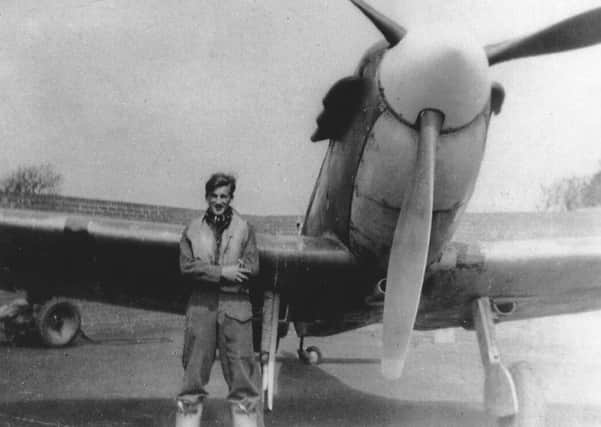Obituary: Nigel Rose, Battle of Britain Spitfire pilot, chartered surveyor, musician and amateur genealogist


The passing of Spitfire pilot Nigel Rose, who fought in the Battle of Britain with RAF No 602 (City of Glasgow) Squadron, brings down to 10 the number of those known still to be alive of almost 3,000 men honoured by Churchill in 1940 as “The Few”.
Nicknamed “Rosebud” by his comrades, Rose destroyed his first enemy “bandit” on 25 August 1940, over the south coast of England. “Attacked Me110 circling from left to right in front and above”, he recorded. “Fired six second burst and saw E/A broke away down emitting white smoke. Followed down to 10,000 ft and as I pulled out and turned saw explosion when E/A struck ground.”
Advertisement
Hide AdAdvertisement
Hide AdDuring the Battle Rose had to fly three or four sorties a day. On 29 October 1940 he claimed the destruction of a Me109, of which he shot off the cockpit cover. The enemy aircraft – one of a force of 50 or 60 – was last seen diving steeply, with “bits falling off”, leaving a thick white trail of smoke. Rose had fired 2,240 rounds of ammunition. It was judged, in official records, as a “probable”.
After the end of October the Luftwaffe concentrated on the night-bombing of London rather than daylight attacks on Fighter Command, but there were still encounters to be had, and Rose’s next “kill” came on the evening of 6 November, where he shared in the destruction of a Ju88.
On another occasion he had a narrow escape when a Me110 attacked him from behind, and his Spitfire began to hurtle, nose down, towards the sea. Wounded in the arm, he struggled to get ready to ditch – but at 8,000ft “I found to my surprise the aircraft was coming out of its dive”. By this time he was only three or four miles from Westhampnett. He landed without brakes, flaps or radio, just short of the hedge beyond the runway. Yet despite getting “a helluva kick”, as he put it, from chasing the enemy with all eight of his aircraft’s machine-guns blazing, it was the friendships between RAF colleagues that Rose remembered best.
“I joined as a sprog and found a wonderful camaraderie,” he recalled. Among his greatest friends was the future fighter ace Osgood Villiers Hanbury, known as “Pedro”, who joined the squadron after it was posted south from Drem in East Lothian, to Westhampnett near Tangmere in West Sussex. The move took place on 13 August. A number of the squadron’s pilots were killed that summer and autumn. Rose reflected: “It might sound strange now, but there simply was not time to grieve.” Pedro would be killed in 1943 after both had left 602 Sqn.
Having joined the RAF Volunteer Reserve in 1938, Rose had accumulated 87 flying hours before the war began. Instead of going through an operational training unit (OTU), he was sent directly to a squadron, such was the need for pilots after Dunkirk and the fall of France in May and June 1940. Newly commissioned as a Pilot Officer, he arrived at Drem in late June.
Transferred to West Sussex, the young pilots enjoyed invitations to dances in the months of the Battle, and it was at one of these, at a squash club near Chichester, that Rose met his future wife, Pamela Anding. They married in 1941. They would have a daughter, Barbara. She was to become the best-selling novelist Barbara Erskine; one of her works, The Darkest Hour (2014), spins a tale beginning with a love-affair during the Battle of Britain.
After the Battle, Rose spent much of the rest of the war as a gunnery instructor, part of it in Scotland, at Armament Practice Camps (APC) in Peterhead and Ayr, and was posted to El Ballah in Egypt before being released from the RAF in 1946.
Stuart Nigel Rose was born in Newcastle-upon-Tyne, the son of an engineer, and educated at Felsted School, Essex. He was good at mathematics, and began an engineering degree at London University, but by 1939 had decided to train as a surveyor. He qualified after the war, becoming a chartered surveyor in 1948, eventually establishing his own firm, Nigel Rose and Partners. His wife died in 1988; two brothers predeceased him. His daughter survives him.
Advertisement
Hide AdAdvertisement
Hide AdA fine draughtsman and keen musician, the quietly-spoken Rose took pleasure also in genealogy, meticulously compiling family trees. He was proud of his Pictish ancestry, from Scotland’s North-east, and in being, through his mother’s line, a direct descendant of Thomas Erskine, the Edinburgh-born 18th-century lawyer who battled against the odds to win acquittals in 1794 for political reformers accused of treason.
Scotland was to count Rose, too, as an honoured son: so impressed was Glasgow’s wartime Lord Provost, Sir Patrick Dollan, by Rose’s and his comrades’ airborne prowess that he promised a permanent memorial in the city to their achievements. Seventy years passed before the pledge was fulfilled, with a granite monument erected in 2013 outside Kelvingrove Art Gallery, long the home to a 602 Sqn Spitfire on display. “Overdue but welcome,” Rose observed.
ANNE KELENY